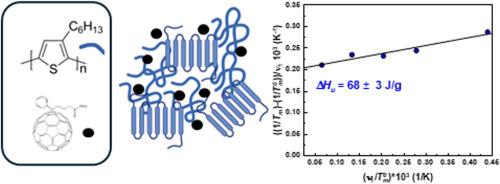Measuring the equilibrium melting enthalpy (ΔH0) and the equilibrium melting temperature (Tm0) of high molecular weight Poly(3-hexylthiophene)
IF 4.5
2区 化学
Q2 POLYMER SCIENCE
引用次数: 0
Abstract
The close correlation between device operation and the degree of crystallinity in semicrystalline semiconducting polymers, e.g. poly(3-hexylthiophene) (P3HT), highlights the need for correct values of the crystal-related thermodynamic parameters from which reliable values of the degree of crystallinity can be calculated. The objective of this work is to provide an overview of the methods used and the equilibrium melting temperature (Tm0) and equilibrium melting enthalpy (ΔH0) values obtained to date, as well as to attempt to reach an agreement on these values. To this end, we investigate the thermodynamic parameters needed to calculate the degree of crystallinity of P3HT by calorimetry. For that, the crystallization behavior and thermodynamics of blends of poly(3-hexylthiophene) (P3HT) and [6,6]-phenyl-C61-butyric acid methyl ester (PCBM), a prototypical electron acceptor molecule, are investigated. The miscibility of the two components in the liquid state was confirmed by the depression of the P3HT melting temperature and the composition-dependent single glass transition temperature (Tg), which follows the Fox equation. Tm0 were determined for neat P3HT and its blends via Hoffman–Weeks extrapolation. These values enabled the application of the Flory–Huggins model, resulting in an ΔH0 of 68 J g-1 for P3HT. This thermodynamic parameter was subsequently used to quantify the degree of crystallinity of P3HT blends. Our approach provides a robust and internally consistent framework for determining the degree of crystallinity in semicrystalline semiconducting polymer systems.

测定高分子量聚(3-己基噻吩)的平衡熔化焓(ΔH0)和平衡熔化温度(Tm0)
器件运行与半晶半导体聚合物(如聚(3-己基噻吩)(P3HT)的结晶度密切相关,这突出表明需要正确的晶体相关热力学参数值,从而可以计算出可靠的结晶度值。这项工作的目的是概述所使用的方法和迄今为止获得的平衡熔化温度(Tm0)和平衡熔化焓(ΔH0)值,并试图就这些值达成一致。为此,我们研究了用量热法计算P3HT结晶度所需的热力学参数。为此,研究了聚(3-己基噻吩)(P3HT)与[6,6]-苯基- c61 -丁酸甲酯(PCBM)共混物的结晶行为和热力学。通过P3HT熔融温度的降低和组分相关的单玻璃化转变温度(Tg),证实了两种组分在液相中的混溶性,其符合Fox方程。通过Hoffman-Weeks外推法测定了纯P3HT及其共混物的Tm0。这些值使Flory-Huggins模型得以应用,从而得到P3HT的ΔH0为68 J g-1。该热力学参数随后被用于量化P3HT共混物的结晶度。我们的方法为确定半晶半导体聚合物系统的结晶度提供了一个强大的和内部一致的框架。
本文章由计算机程序翻译,如有差异,请以英文原文为准。
求助全文
约1分钟内获得全文
求助全文
来源期刊

Polymer
化学-高分子科学
CiteScore
7.90
自引率
8.70%
发文量
959
审稿时长
32 days
期刊介绍:
Polymer is an interdisciplinary journal dedicated to publishing innovative and significant advances in Polymer Physics, Chemistry and Technology. We welcome submissions on polymer hybrids, nanocomposites, characterisation and self-assembly. Polymer also publishes work on the technological application of polymers in energy and optoelectronics.
The main scope is covered but not limited to the following core areas:
Polymer Materials
Nanocomposites and hybrid nanomaterials
Polymer blends, films, fibres, networks and porous materials
Physical Characterization
Characterisation, modelling and simulation* of molecular and materials properties in bulk, solution, and thin films
Polymer Engineering
Advanced multiscale processing methods
Polymer Synthesis, Modification and Self-assembly
Including designer polymer architectures, mechanisms and kinetics, and supramolecular polymerization
Technological Applications
Polymers for energy generation and storage
Polymer membranes for separation technology
Polymers for opto- and microelectronics.
 求助内容:
求助内容: 应助结果提醒方式:
应助结果提醒方式:


